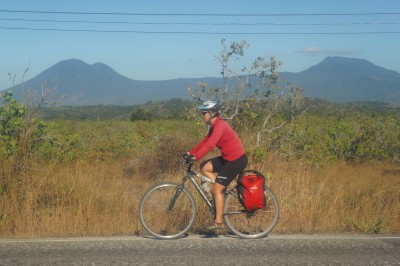
Costa Rica: The Beauty and the Beast

Costa Rica has a problem. It is too beautiful, too attractive, and too peaceful, attracting millions of tourists each year. Its fitting image of paradise on earth is one of the “problems”. We strategically avoided staying in touristy areas, preferring the less known places, small towns or villages, and they do exist in Costa Rica, even though we’ve heard that “tourists are everywhere”. By doing this, what we discovered is indeed a beautiful country, in both landscape and people.
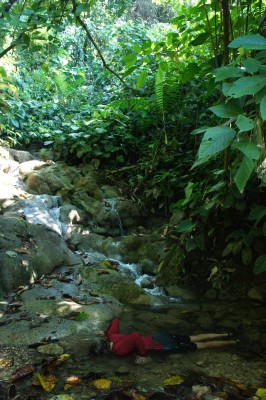
We crossed the border from Panama at Paso Canoa and it took us a while to figure out where to get our passports stamped and so on. Welcome to Costa Rica! Here we connected with the Panamerican Highway again, but it didn’t seem like it at all. The road was one lane in each direction, no shoulders, but surprisingly little traffic too. At times we were cycling through thick and steamy jungle where every now and then we would find a much appreciated hidden waterfall with a small pool, which we called “cold springs.”

In Palmar Sur we admired mysterious pre-Columbian rock spheres, which seem to just lay around town, in the park, in a college and a few other places. No one knows the true story behind these perfectly round shaped granite balls of various sizes. We then left the Panamericana and took the coastal road to Bahia Ballena and visited the marine national park. The air was unbearably humid but once we were near the ocean the air was fresh. The park is a stretch of wild undeveloped beaches that stretch each way for many kilometers. During low tide we walked way out into the ocean on a narrow land tongue. We camped under a star fruit tree in the village near by. The place we stayed at had a well equipped kitchen, so we made toasted sandwiches, fish and banana shakes.

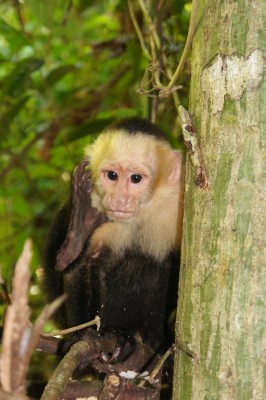
Near the town of Quepos we visited the Manuel Antonio national park, which is well known and attracts many tourists. The reason is that one can see wildlife there without much effort. We arrived early just as the park opened so for two hours we had the park all to ourselves, until the hordes arrived, mostly led by guides with huge telescopes. Nonetheless we spotted many animals, sometimes thanks to those big groups, such as white faced monkeys and raccoons. The highlight was a mother sloth with a baby on its back, munching on the leaves of a tree.
However, wild life was easy to spot in Costa Rica even just off the road. We once cycled and looked down from a bridge, and in the river below us there was a group of about 30 crocodiles. On a different occasion we looked up and there was a group of bright red scarlet macaw parrots flying over our heads. Every now and then we spotted monkeys crossing power lines like acrobats or swinging off trees, or we would hear the wild howls of the howler monkeys. Seeing iguanas was a daily occasion, and the road also seemed like a grave yard for snakes, sometimes really big ones.
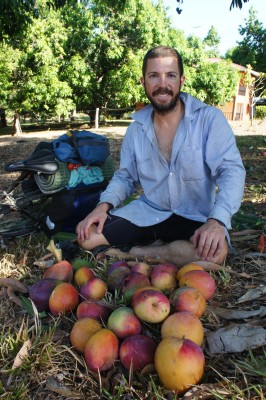
Fruit was also a big attraction, especially mangoes. When we cycled in Panama we passed many mango trees, but with no ripe fruit, it was almost as if they were mocking us. When we asked the locals they all said that the season is much later, closer to April, and we began to wonder if we hadn’t made a mistake not doing the trip in the other direction. But once we crossed to Costa Rica there were mangoes everywhere, and every time we bought mangoes and asked where they had come from the answer was the same: Orotina.
Indeed when we got closer to Orotina mango trees with ripe fruit suddenly appeared, and then fruit stands one right after the other. We stopped at an orchard where the mangoes were picked recently, and chatted with the owner. We had a quick feast below the towering trees and collected a little mountain of the bright red and yellow fruit.
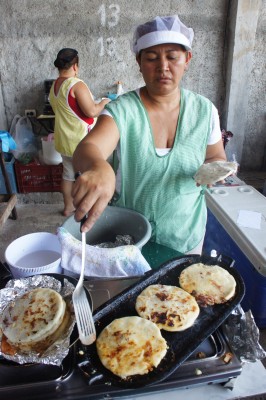
We hadn’t planned to stop in Orotina, since it wasn’t exactly on our way. When we stopped at one of the fruit stands, the two girls working there said that Orotina is known as the city of fruit and that we are now in the “mango zone” (zona de mango). They also mentioned that on Fridays there is a fruit fair in Orotina, and it was Friday! We looked at each other and without saying anything we both knew what was coming next – we were going to cycle to Orotina. We bought a few mangoes from those girls, but then noticed that they were throwing many mangoes aside, to give to their animals. They looked perfectly fine to us, so they said we could take as many as we wanted for free. We ended up cycling to Orotina with 30 or so mangoes…
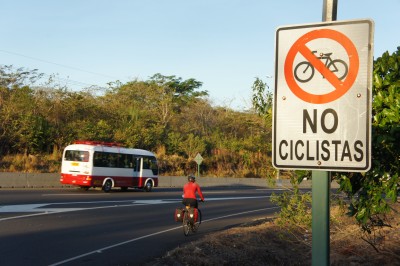
When we arrived, the fruit market was alive and kicking, but obviously we didn’t need any more mangoes. There was a woman there making pupusas, an El Salvodorian flat bread filled with beans and cheese or meat, which was a refreshing change from the rice and beans we’ve been eating every day. At the hotel where we stayed, clients that paid by the hour continually came and went. Gili borrowed the blender from the owner and made us a few huge mango shakes. We were both in urgent need of a rest day, and Orotina was a perfect place for it.
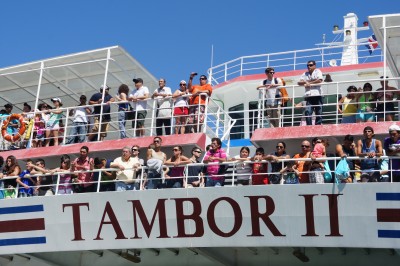

After the refreshing rest we made our way to the Nicoya peninsula. We cycled along the toll highway to the rough looking town of Puntarenas and without knowing the schedule of the ferry, we caught the ferry just as it was leaving. The ferry ride reminded us of our cycling trips to the Gulf Islands in BC. Once on the Nicoya the road became smaller and quieter. After a long day we needed a place to sleep. In the tiny village of Florida, which doesn’t even appear on our map, we asked a couple if we could camp in their yard. Not only did they not mind, they offered us a room in their house instead. They said that they have five rooms in their house, but they are only two people, so we might as well make use of one of their extra rooms.

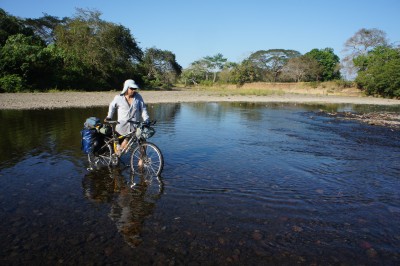
The next few days took us to the wild west of the Nicoya Peninsula. The roads were rough gravel, sometimes climbing very steeply, so we had to push our bikes quite a bit, sometimes walking our bikes downhill as well. The views were rewarding though. Dramatic vistas of undeveloped beaches, rocky points and small villages. One day we rode for about 10 kilometers right on the beach. It was low tide and the sand was hard enough that our tires barely left a mark. It felt surreal to ride on the wide expanse of sand, hearing the breaking waves, and seeing the beautiful wavy sand formations. For Gili it was a dream come true as he had always wanted to ride along a beach.
In the village of San Miguel we had to leave the shore line. We stopped for lunch at the only restaurant in the area, and Gili befriended a guy with a machete and they went to hunt a few coconuts for us while the food was being prepared. When the food came and we were sitting in the private restaurant over looking the ocean and drinking huge coconuts, Gili said that it is almost like we are on a relaxing vacation…
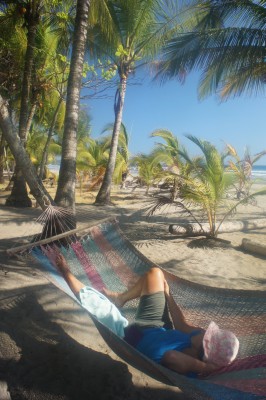
We both didn’t want to leave this charming place, and when Ana, the owner of the restaurant, offered us to camp in her yard it was a done deal – we were going to take a rest day in San Miguel. There was nothing much to do there, which was perfect, so we passed our time gulping one coconut after another, swimming and relaxing on a hammock. Ana also had the cutest little puppy, Puka, which I could have easily adopted. In the end not only did Ana not charge us for camping, she also offered to do our laundry. In the morning she left us a present – two magnets of Costa Rica, and an emotional note thanking us for coming to visit, and that she hopes we will remember San Miguel when we’ll put those magnets on the fridge. We will.

Our final day on gravel took us up above the ocean and then a dramatic descent to the colourful village of Islita. In this village there are many colourful murals and mosaics created by local artists. Everything is decorated, from the preschool to the grocery store. Ten kilometers before Samara the road was suddenly paved again, l don’t think I was ever that happy to see a paved road.
We camped on the farthest beach in Samara, but could still hear the all night party from town. After spending our time in out of the way small places, that was too much. So the next day we rode all the way to the tiny town of Filadelfia, which I assume is nothing like Philadelphia.

Cycling into the city of Liberia was uneventful. There we connected with the Panamericana once again, and we didn’t expect that our last section on the “main road” in Costa Rica would be the most isolated and desert-like that we’ve ridden in the country. There were no villages on the way and no places to eat or get water. We found one house in the middle of nowhere and asked for some water. The water came from a well in their yard. Then we cooked our lunch, hiding in the shade of their house, while chicken and pigs ran around. Their two year old with neon pink underwear was very interested in us, although she kept herself entertained.

Then we finally reached the town of La Cruz, up on a hill surrounded by the ocean on one side and nothingness on the other side. It was our last stop in Costa Rica and we stayed for three nights at a mom-and-pop hotel, where they were excited to have us around.
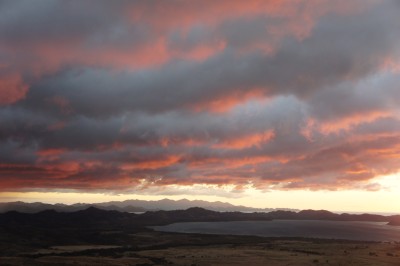
On our last full day in Costa Rica something really strange happened – we woke up in the morning and it was raining! There was a strong wind that rattled the roof and I suddenly realized how much we had taken the sun for granted until then. We still didn’t change our plans of doing a day trip to the beach of Puerto Soley. Again we found a beautiful undeveloped beach, and it was just us and a few stray dogs around.
It was then time to leave Costa Rica, the country we’ve learned to love. Let’s just hope that the beast won’t take over everything and that the beauty is there forever for everyone to enjoy.
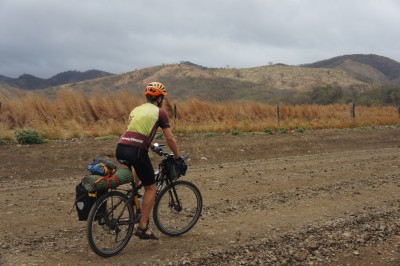
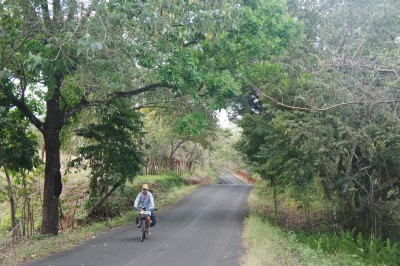
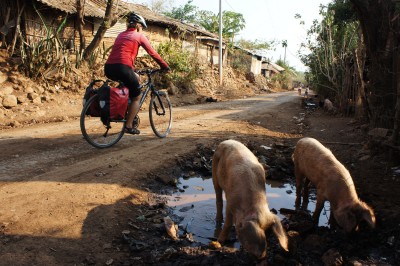
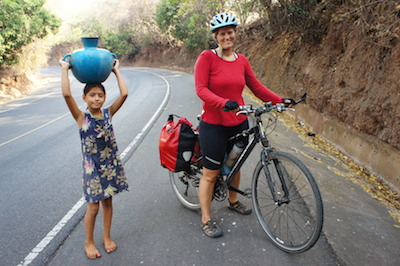
2 Comments
Doris Leong
Love reading about your adventures! Glad you’re having such a fabulous time, guys!
Pingback: